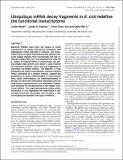Ubiquitous mRNA decay fragments in E. coli redefine the functional transcriptome
Author(s)
Herzel, Lydia; Stanley, Julian A; Yao, Chun-Chen; Li, Gene-Wei
DownloadPublished version (3.819Mb)
Publisher with Creative Commons License
Publisher with Creative Commons License
Creative Commons Attribution
Additional downloads
Open Access Policy
Open Access Policy
Creative Commons Attribution-Noncommercial-Share Alike
Terms of use
Metadata
Show full item recordAbstract
<jats:title>Abstract</jats:title>
<jats:p>Bacterial mRNAs have short life cycles, in which transcription is rapidly followed by translation and degradation within seconds to minutes. The resulting diversity of mRNA molecules across different life-cycle stages impacts their functionality but has remained unresolved. Here we quantitatively map the 3’ status of cellular RNAs in Escherichia coli during steady-state growth and report a large fraction of molecules (median&gt;60%) that are fragments of canonical full-length mRNAs. The majority of RNA fragments are decay intermediates, whereas nascent RNAs contribute to a smaller fraction. Despite the prevalence of decay intermediates in total cellular RNA, these intermediates are underrepresented in the pool of ribosome-associated transcripts and can thus distort quantifications and differential expression analyses for the abundance of full-length, functional mRNAs. The large heterogeneity within mRNA molecules in vivo highlights the importance in discerning functional transcripts and provides a lens for studying the dynamic life cycle of mRNAs.</jats:p>
Date issued
2022Department
Massachusetts Institute of Technology. Department of BiologyJournal
Nucleic Acids Research
Publisher
Oxford University Press (OUP)
Citation
Herzel, Lydia, Stanley, Julian A, Yao, Chun-Chen and Li, Gene-Wei. 2022. "Ubiquitous mRNA decay fragments in E. coli redefine the functional transcriptome." Nucleic Acids Research, 50 (9).
Version: Final published version